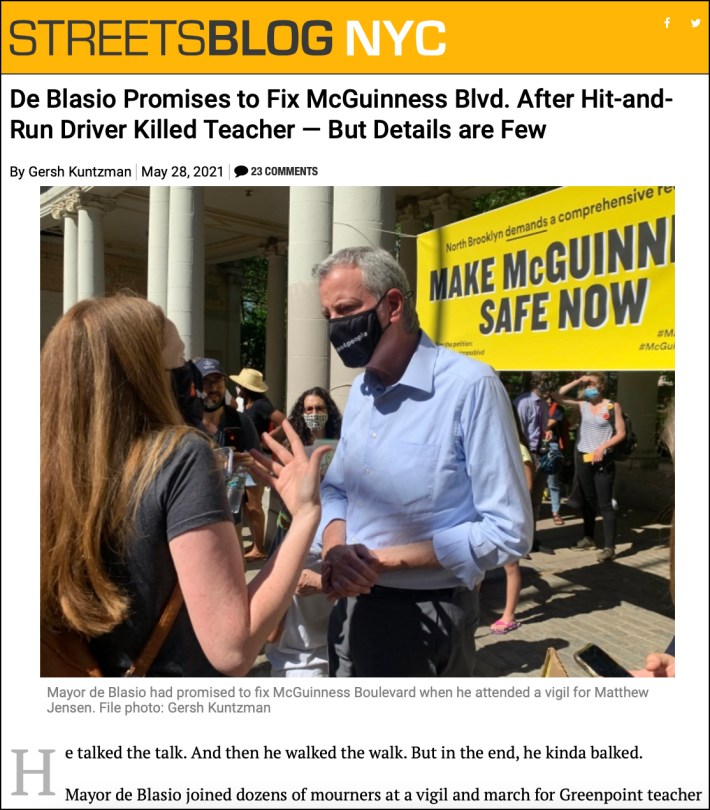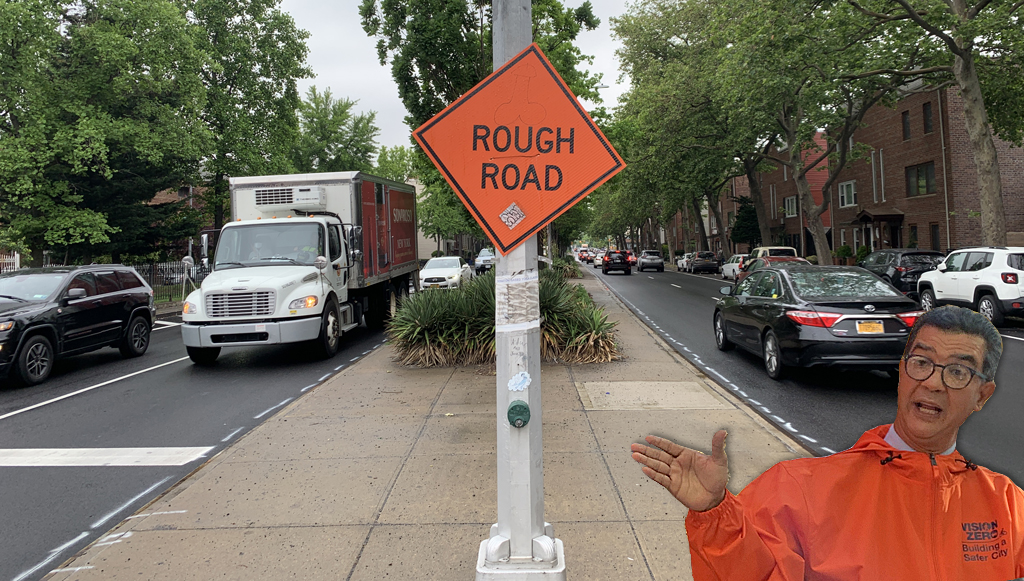The "Calyer Compromise" is coming soon.
After weeks of controversy and an 11th-hour redesign, the Department of Transportation said on Tuesday that it will finally begin redesigning McGuinness Boulevard in a way that will "save lives and make this corridor much easier to navigate for everyone, including drivers, pedestrians, and cyclists," according to Commissioner Ydanis Rodriguez.
It's the first time the DOT has both revealed the timeline for the redesign — which began being planned after a local teacher was killed in a hit-and-run in May 2021 — and formally confirmed that its plans now include two differently designed segments rather than the simple "road diet" that had been announced by DOT earlier this year.
Instead of a single lane for cars and trucks between the Pulaski Bridge and Meeker Avenue, the DOT plan now calls for two segments, both with a bike lane against the curb on both sides of the roadway:
- Between the Pulaski Bridge and Calyer Street, McGuinness will consist of two lanes of car and truck traffic in both directions between 7 a.m. and 7 p.m. After 7 p.m., the "flex lane" will become a parking lane. This segment will be built first and will be finished by the end of the year.
- Between Calyer Street and Meeker Avenue, the DOT will construct a traditional road diet, meaning that the current two-lane-in-each-direction roadway will slim to one lane in each direction. There will be dedicated loading zones to accommodate the crush of deliveries, both residential and commercial (and hopefully reduce double-parking). There will also be “offset crossings” at intersections, which calm car and truck turns and reduce conflicts. DOT will begin work on this section only after completing the northern section.
- The DOT added that the protection for the bike lanes will include hard barriers and flexible delineators, which the agency said is necessary to allow passengers in cars to access the curb.
The DOT provided background information to reporters claiming that the design will enhance safety by reducing speeding, but the original design released in May would have put all of McGuinness on a full time road diet, not just the segment south of Calyer.
The DOT was poised to move ahead with its design until powerful neighborhood interests and political donors, who were not actively involved in the years of discussions and outreach conducted by DOT, got the ear of powerful mayoral adviser Ingrid Lewis-Martin, a known opponent of road redesigns.
Lewis-Martin convinced Mayor Adams that there was significant opposition to the DOT's plans, prompting the mayor to order up a compromise — the one that DOT now intends to start building next week, with crews posting informational fliers as early as this week.
Rodriguez did not refer to the compromise in his statement.
“We are committed to reducing traffic deaths on dangerous corridors like McGuinness Boulevard and look forward to bringing these designs that have proven to enhance safety," he said. "We thank Mayor Adams, the elected officials, and the community for their support in this project.”
That "support" is somewhat weak. Supporters of the redesign issued a statement earlier this month saying "the new plan does not include every element that we have advocated for or was part of the DOT’s announcement in May," but nonetheless called the truncated "Calyer Compromise" "a critical step in the right direction and ... the most significant safety interventions on McGuinness Boulevard since Robert Moses expanded the road 70 years ago."
Meanwhile, the late-to-emerge opponents of the project — including a group called Keep McGuinness Moving that opposes the road diet and was organized by the powerful Argento family — say they will rally in a Key Food parking lot on Sept. 12.
The compromise, the group said in a statement, does not "address any of the concerns, worries, or issues expressed by the community."
The DOT said its compromise to keep two lanes of traffic north of Calyer during peak hours does indeed address one major concern of the group: the ability of commercial vehicles to get around in the unsafe manner with which they have been getting around for years.
The agency told reporters that a vast majority of truck traffic to Greenpoint’s Industrial Business Zone does not travel on McGuinness Boulevard, and the small portion that does uses the north end of the corridor.
Keep McGuinness Moving has claimed it is a safety group, so if that is true, it should be pleased with the DOT's other announcement on Tuesday — that the stretch south of Calyer Street will get new pedestrian islands at each crosswalk, which will shorten pedestrian crossings by 23 percent in length, and the agency said, discourage cut-through traffic.
The long saga that begins its conclusion next week began decades ago when then Oakland Street was widened in the 1950s to accommodate the new Pulaski Bridge and give drivers a cut-through from the Brooklyn-Queens Expressway.
Over the years, many have died on the strip. And in just the last decade, three people, including beloved local teacher Matthew Jensen, died in crashes, and a whopping 389 people were injured in 1,690 reported crashes — nearly one every other day on just a short stretch of one roadway.

After the Jensen killing, then-Mayor Bill de Blasio toured the area and promised a $40-million safety redesign. Mayor Adams supported the project until he suddenly didn't — and in July ordered the DOT back to the drawing board. That request came at the behest of the Powerful Argento family, which operates the neighborhood's main landholder, Broadway Stages, and has given richly to local pols: hundreds of thousands of dollars in campaign contributions over the years, including $80,000 to the Brooklyn Democratic Party machine and $15,000 to Mayor Adams's campaigns.
Broadway Stages also gave a half-million dollars to a non-profit controlled by Adams when he was Brooklyn Borough President, the Daily News reported.
Streetsblog reached out to DOT for one clarification on how southbound traffic would flow south of Calyer Street as it narrows from two lanes to one, but the agency said it has taken that circumstance into consideration and is not concerned about backups.






